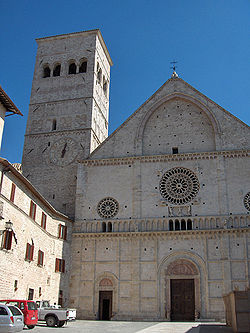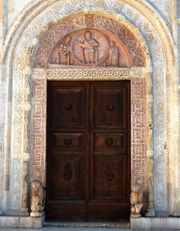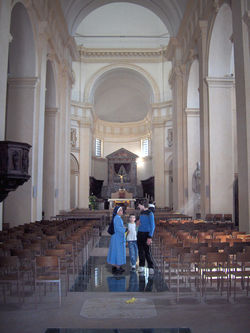
Cathedral of San Rufino
Encyclopedia

Rufinus of Assisi
According to legend, Rufinus of Assisi , who is the patron saint of Assisi, Italy, was the first bishop of Assisi. He was responsible for converting Assisi to Christianity, but at what date is disputed...
) is a major church in Assisi
Assisi
- Churches :* The Basilica of San Francesco d'Assisi is a World Heritage Site. The Franciscan monastery, il Sacro Convento, and the lower and upper church of St Francis were begun immediately after his canonization in 1228, and completed in 1253...
, Italy, that has been important in the history of the Franciscan order. In this church Saint Francis of Assisi
Francis of Assisi
Saint Francis of Assisi was an Italian Catholic friar and preacher. He founded the men's Franciscan Order, the women’s Order of St. Clare, and the lay Third Order of Saint Francis. St...
(1182), Saint Clare
Clare of Assisi
Clare of Assisi , born Chiara Offreduccio, is an Italian saint and one of the first followers of Saint Francis of Assisi...
(1193) and many of their original disciples were baptised. It was on hearing Francis preaching in this church in 1209 that Clare became deeply touched by his message and realized her calling. Tommaso da Celano related that once Saint Francis was witnessed praying in this church while, at the same time, he was seen jumping on a chariot of fire in the Porziuncola
Porziuncola
Porziuncola, also called Portiuncula or Porzioncula, Porciúncula is a small church located within the Basilica of Santa Maria degli Angeli in the frazione of Santa Maria degli Angeli, situated about from Assisi, Umbria...
.
This stately church in Umbria
Umbria
Umbria is a region of modern central Italy. It is one of the smallest Italian regions and the only peninsular region that is landlocked.Its capital is Perugia.Assisi and Norcia are historical towns associated with St. Francis of Assisi, and St...
n Romanesque
Romanesque architecture
Romanesque architecture is an architectural style of Medieval Europe characterised by semi-circular arches. There is no consensus for the beginning date of the Romanesque architecture, with proposals ranging from the 6th to the 10th century. It developed in the 12th century into the Gothic style,...
style was the third church built on the same site to contain the remains of bishop Rufinus of Assisi, martyred in the 3rd century. The construction was started in 1140 to the designs by Giovanni da Gubbio, as attested by the wall inscription visible inside the apse. He may be the same Giovanni who designed the rose-window on the façade of Santa Maria Maggiore in 1163.
In 1228, while he was in Assisi for the canonization of Saint Francis, Pope Gregory IX consecrated the high altar. Pope Innocent IV inaugurated the finished church in 1253.
Façade
The Romanesque façade was built with stones from the Monte SubasioMonte Subasio
Mount Subasio is a mountain of the Apennine mountains, in the province of Perugia, Umbria, central Italy. On its slopes are located the ancient towns of Assisi and Spello.The mountain stands about 1290 metres above sea level....
. It is a typical example of the style found in 12th-century churches of Umbria. This façade is divided in three sections.
- The rather bare top level is triangular with an empty semi-circular arch in the middle, probably intended to contain a friezeFriezethumb|267px|Frieze of the [[Tower of the Winds]], AthensIn architecture the frieze is the wide central section part of an entablature and may be plain in the Ionic or Doric order, or decorated with bas-reliefs. Even when neither columns nor pilasters are expressed, on an astylar wall it lies upon...
or a mosaicMosaicMosaic is the art of creating images with an assemblage of small pieces of colored glass, stone, or other materials. It may be a technique of decorative art, an aspect of interior decoration, or of cultural and spiritual significance as in a cathedral...
.

- The middle level is divided by two pilasters, in line with the arch in the upper level. Each of the bayBay (architecture)A bay is a unit of form in architecture. This unit is defined as the zone between the outer edges of an engaged column, pilaster, or post; or within a window frame, doorframe, or vertical 'bas relief' wall form.-Defining elements:...
thus delineated contains a rose windowRose windowA Rose window is often used as a generic term applied to a circular window, but is especially used for those found in churches of the Gothic architectural style and being divided into segments by stone mullions and tracery...
, the central one the largest and the most ornate. Its frame is supported by three telamonTelamonIn Greek mythology, Telamon , son of the king Aeacus, of Aegina, and Endeis and brother of Peleus, accompanied Jason as one of his Argonauts, and was present at the hunt for the Calydonian Boar. In the Iliad he was the father of Greek heroes Ajax the Great and Teucer the Archer by different...
es, each standing on an animal. In the four spandrelSpandrelA spandrel, less often spandril or splaundrel, is the space between two arches or between an arch and a rectangular enclosure....
s around the rose window are the four animal symbols of the four evangelists. - The lower level consists of a number of squares and three decorated stone portals with griffinGriffinThe griffin, griffon, or gryphon is a legendary creature with the body of a lion and the head and wings of an eagle...
s at the base of the side portals. Especially the middle portal is extensively decorated. In the lunetteLunetteIn architecture, a lunette is a half-moon shaped space, either filled with recessed masonry or void. A lunette is formed when a horizontal cornice transects a round-headed arch at the level of the imposts, where the arch springs. If a door is set within a round-headed arch, the space within the...
of the semi-circular arch over the central portal is a reliefReliefRelief is a sculptural technique. The term relief is from the Latin verb levo, to raise. To create a sculpture in relief is thus to give the impression that the sculpted material has been raised above the background plane...
with the Christ enthroned between the sun and the moon and flanked by the Virgin, also enthroned and nursing Jesus, and St. Rufinus. The portal is surrounded with three arches decorated with saints, floral and geometrical motifs and intertwined swans. At the base of the middle arch, on each side, is a lion. These sculptures of lions and griffins have great iconographic importance.
The bottom and the middle part of the square bell tower
Bell tower
A bell tower is a tower which contains one or more bells, or which is designed to hold bells, even if it has none. In the European tradition, such a tower most commonly serves as part of a church and contains church bells. When attached to a city hall or other civic building, especially in...
, on the left side of the façade, were built in the 11th century. It was then situated behind the apse of the previous church built by bishop Ugone in 1029. The top level dates from the 13th century. One can see on the bell tower a colossal one-handed liturgical clock showing the 24 hours of the hora italica (Italian time), a period of time ending with sunset at 24 hours. The foundations of the bell tower rest on a Roman cistern. The structure on the side of the bell tower has been identified as the home of St. Clare.
Interior

Italian Renaissance
The Italian Renaissance began the opening phase of the Renaissance, a period of great cultural change and achievement in Europe that spanned the period from the end of the 13th century to about 1600, marking the transition between Medieval and Early Modern Europe...
by the architect Gian Galeazzo Alessi from Perugia
Perugia
Perugia is the capital city of the region of Umbria in central Italy, near the River Tiber, and the capital of the province of Perugia. The city is located about north of Rome. It covers a high hilltop and part of the valleys around the area....
. It consists of a central nave
Nave
In Romanesque and Gothic Christian abbey, cathedral basilica and church architecture, the nave is the central approach to the high altar, the main body of the church. "Nave" was probably suggested by the keel shape of its vaulting...
, two aisle
Aisle
An aisle is, in general, a space for walking with rows of seats on both sides or with rows of seats on one side and a wall on the other...
s, separated by massive pillars, an apse
Apse
In architecture, the apse is a semicircular recess covered with a hemispherical vault or semi-dome...
and a dome
Dome
A dome is a structural element of architecture that resembles the hollow upper half of a sphere. Dome structures made of various materials have a long architectural lineage extending into prehistory....
.
In the interior, at the baptismal font
Baptismal font
A baptismal font is an article of church furniture or a fixture used for the baptism of children and adults.-Aspersion and affusion fonts:...
at the beginning of the right aisle, Saint Francis was baptised in 1182 and Saint Clare in 1193, as were many of their original followers, and in 1838 Saint Gabriel of Our Lady of Sorrows
Gabriel of Our Lady of Sorrows
Saint Gabriel of Our Lady of Sorrows was an Italian Passionist clerical student. Born to a professional family, he gave up hopes of a secular career to enter the Passionist Congregation...
. The font was fashioned from an ancient granite column and is girdled by an iron grating. The terracotta tabernacle
Church tabernacle
A tabernacle is the fixed, locked box in which, in some Christian churches, the Eucharist is "reserved" . A less obvious container, set into the wall, is called an aumbry....
was a present in 1882 on the occasion of the 700th anniversary of Saint Francis's birth.
On the right aisle is the Chapel of the Blessed Sacrament in Baroque style (begun in 1541 and enlarged in 1663), partly frescoed in 1663 by the local painter Giacomo Giorgetti, a pupil of Giovanni Lanfranco
Giovanni Lanfranco
Giovanni Lanfranco was an Italian painter of the Baroque period.-Biography:Giovanni Gaspare Lanfranco was born in Parma, the third son of Stefano and Cornelia Lanfranchi, and was placed as a page in the household of Count Orazio Scotti...
. The nine wall paintings are attributed to the 17th-century painter Andrea Carlone
Andrea Carlone
Andrea Carlone was an Italian painter of the Baroque period, active mainly in his natal city of Genoa.He was the son of the painter Giovanni Battista Carlone and Niccoletta Scorza. He traveled and painted extensively through Italy. After initial work with his father, he traveled to Venice for a...
.
The Chapel of Our Lady of Consolation was built in 1496 as a consequence of a miracle. In 1494 people had seen the image of Our Lady of Sorrows weeping over the Christ in her arms. This German terracotta sculpture from the early 15th century has recently been stolen. An identical wooden copy now stands at the same place.
The 19th-century main altar stands under the octagonal Renaissance crossing dome over the remains of Saint Rufinus. On both sides stand the marble statues of Saint Francis and Saint Clare by Giovanni Duprè
Giovanni Duprè
Giovanni Duprè was an Italian sculptor, of distant French stock long settled in Tuscany, who developed a reputation second only to his contemporary Lorenzo Bartolini.-Biography:...
. In the apse stands the majestic choir, with 22 stalls, decorated with wooden carvings by Giovanni di Pier Jacopo da San Severino (1520). The statue of Saint Rufinus by Lemoyne stands at the center of the choir.
There are several paintings by Dono Doni
Dono Doni
Dono Doni, also known as Adone Doni or Dono dei Doni, who was born at Assisi, early in the 16th century, is said to have been a disciple of Pietro Perugino. His style retained but little of the Gothic manner of that master, and in his later years he abandoned the style of the school of Raphael, and...
: Christ adored by Saints (1555); on the two altars on both sides of the major one, there are two more works: Deposition (1562) and Crucifixion (1563).
Under the cathedral there is a crypt with the pagan Roman sarcophagus
Sarcophagus
A sarcophagus is a funeral receptacle for a corpse, most commonly carved or cut from stone. The word "sarcophagus" comes from the Greek σαρξ sarx meaning "flesh", and φαγειν phagein meaning "to eat", hence sarkophagus means "flesh-eating"; from the phrase lithos sarkophagos...
from the 3rd century, asserted to have once contained the remains of Saint Rufinus. It bears across its front, as many sarcophagi do, a bas-relief with the myth of Diana and Endymion, offering a pagan vision of tranquil afterlife
Afterlife
The afterlife is the belief that a part of, or essence of, or soul of an individual, which carries with it and confers personal identity, survives the death of the body of this world and this lifetime, by natural or supernatural means, in contrast to the belief in eternal...
. Here are also the Pozzo della Mensa, a medieval well and the ruins of a Carolingian
Carolingian
The Carolingian dynasty was a Frankish noble family with origins in the Arnulfing and Pippinid clans of the 7th century AD. The name "Carolingian", Medieval Latin karolingi, an altered form of an unattested Old High German *karling, kerling The Carolingian dynasty (known variously as the...
cloister from the 10th century.
Museo del Duomo
The Museo Diocesano e Cripta di San Rufino (Museum of the Cathedral and Crypt of San Rufino) was opened in 1941. It contains the following works associated with the cathedral:- Front of 2nd century AD Roman sarcophagus con Nikai Clipeofore e a libation scene.
- Detached frescoes of Mary and Christ by the Master of Saint Clare (last quarter of 13th century).
- Detached frescoes on Passion and Crucifixion by Puccio CapannaPuccio CapannaPuccio Capanna was an Italian painter of the first half of the 14th century, who lived and worked in Assisi, Umbria, Italy between 1341 and 1347. He is also called Puccio Campana.Capanna was originally a Florentine...
(1334), once in the Oratory of San Rufinuccio. - Processional standards of the Confraternity di San Francesco e San Leonardo (1378) by the Master of the Gonfalone di San Leonardo.
- Reliquary containing wood from the 'true cross' (second half of 15th century), in gilded gold.
- PolyptychPolyptychA polyptych generally refers to a painting which is divided into sections, or panels. The terminology that follows is in relevance to the number of panels integrated into a particular piece of work: "diptych" describes a two-part work of art; "triptych" describes a three-part work; "tetraptych"...
of the Story of San Rufino (1462) by Niccolò AlunnoNiccolò AlunnoNiccolò Alunno was an Italian painter of the Umbrian school.He was born at Foligno, the son of speziali. He was a pupil of Bartolomeo di Tomaso; his master's assistant was Benozzo Gozzoli, the pupil of Fra Angelico. The simple Umbrian feeling in his work was somehow modified by this Florentine...
. - Aedicule of the Confraternity of the SS. Sacramento (c. 1475); detached frescoes by Matteo da Gualdo.
- Predella in two leaves (1563) by Dono DoniDono DoniDono Doni, also known as Adone Doni or Dono dei Doni, who was born at Assisi, early in the 16th century, is said to have been a disciple of Pietro Perugino. His style retained but little of the Gothic manner of that master, and in his later years he abandoned the style of the school of Raphael, and...
, depicting St. Gregory Magnus and St. Lawrence. - Processional standards of the Confraternity of Santa Caterina d’Alessandria (1627) by Orazio RiminaldiOrazio RiminaldiOrazio Riminaldi was an Italian painter of the Baroque period.Riminaldi was born at Pisa. He was a pupil of the painter Ranieri Borghetti, then Aurelio Lomi, and finally Orazio Gentileschi. He painted in a Caravaggist style in Rome, and returned to Pisa, ultimately choosing a muted style. He...
. - 'Dying San Francis blesses the city of Assisi (1640), canvas by Cesare Sermei, originally in the Palazzo Vescovile.
- Processional standards of the Confraternity of San Lorenzo (1673) by Giovanni Andrea Carlone.
- Other works by Pace di Bartolo, Giovanni di Pieriacopo da San Severino, Lorenzo Doni, Raffaello Coda e Girolamo Marinelli.
- Liturgical documents and equipment from the 17th century to present.
- The Perkins collection composed of 32 works including Giovanni BoccatiGiovanni BoccatiGiovanni Boccati was an Italian painter, born in Camerino. He painted a Virgin and Child enthroned, and surrounded by Angels, Seraphim, and Saints in Perugia.The Sinebrychoff Art Museum in Helsinki,Finland has a painting by this painter.-References:...
, Jacopo della QuerciaJacopo della QuerciaJacopo della Quercia was an Italian sculptor of the Italian Renaissance, a contemporary of Brunelleschi, Ghiberti and Donatello. He is considered a precursor of Michelangelo.-Biography:...
, Filippo LippiFilippo LippiFra' Filippo Lippi , also called Lippo Lippi, was an Italian painter of the Italian Quattrocento .-Biography and works:...
, Francesco di Giorgio Martini, and Giovanni SantiGiovanni SantiGiovanni Santi was an Italian painter and decorator, father of Raphael. He was born at Colbordolo in the Duchy of Urbino. He was a petty merchant for a time; he then studied under Piero della Francesca. He was influenced by Fiorenzo di Lorenzo, and seems to have been an assistant and friend of...
.

